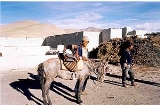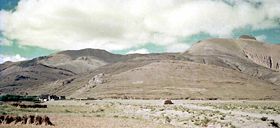
Tingri
Encyclopedia
Tingri or Dingri or Dhingri ' onMouseout='HidePop("58091")' href="/topics/Wylie_transliteration">Wylie
: Ding-ri; Chinese
: 定日; Pinyin
: Dìngrì = 'Lawn Mountain') is a town in southern Tibet
. It is in Tingri County
, Shigatse Prefecture with a population of around 523. It is often used as a base by mountain climbers preparing to ascend Mount Everest
or Cho Oyu
.Tingri Shekar (Dring ri Shel dkar) is a small town approximately 60 km north-west of Mount Everest
and just over 50 km from the Nepali border in the Tibet Autonomous Region
of China
. It is at an altitude of about 4,300 metres (approx. 14,107 feet). The old Shekar Dorje Dzong, or fort, is above the new town and used to enclose Shekar Chode, a Gelug
monastery which was completely destroyed but is being restored. It is known for its spectacular views of Mount Everest
, Mount Lhotse
, Mount Makalu
, and Cho Oyu
, which comprise four of the six highest mountains in the world.
 Tingri used to be an important trading post where Sherpas from Nepal
Tingri used to be an important trading post where Sherpas from Nepal
exchanged rice
, grain
and iron
for Tibetan wool
. livestock
and salt
. It gives its name to the broad upland basin more than 4,500 metres high that is known as the Tingri Plain
. One must cross the pass known as the Lakpa La (5,220 m) to the north to reach the Tsangpo
Valley system. Shallow, fast-flowing rivers of melted snow water make its grassy meadowland ideal for grazing by Tibetan animals. The plain used to abound with gazelles, blue sheep, antelopes and khyang or wild asses but, unfortunately, most of the animals are gone now. The Chinese army has a small base nearby.

 Tingri Lankor (Ding ri glang 'khor) — Padampa's Residence was founded in 1097 CE by the South Indian Buddhist adept, Padampa Sangye (died 1117) who made five visits to Tibet and was an important person in the re-establishment of the Buddhadharma in Tibet. His consort was the famous Tibetan dakini
Tingri Lankor (Ding ri glang 'khor) — Padampa's Residence was founded in 1097 CE by the South Indian Buddhist adept, Padampa Sangye (died 1117) who made five visits to Tibet and was an important person in the re-establishment of the Buddhadharma in Tibet. His consort was the famous Tibetan dakini
Machik Labdron. The gompa or temple was built in the Padampa Sange's meditation cave and became the seat of the Dampapa School of Tibetan Buddhism. It is in the process of restoration.
Wylie transliteration
The Wylie transliteration scheme is a method for transliterating Tibetan script using only the letters available on a typical English language typewriter. It bears the name of Turrell V. Wylie, who described the scheme in an article, A Standard System of Tibetan Transcription, published in 1959...
: Ding-ri; Chinese
Chinese character
Chinese characters are logograms used in the writing of Chinese and Japanese , less frequently Korean , formerly Vietnamese , or other languages...
: 定日; Pinyin
Pinyin
Pinyin is the official system to transcribe Chinese characters into the Roman alphabet in China, Malaysia, Singapore and Taiwan. It is also often used to teach Mandarin Chinese and spell Chinese names in foreign publications and used as an input method to enter Chinese characters into...
: Dìngrì = 'Lawn Mountain') is a town in southern Tibet
Tibet
Tibet is a plateau region in Asia, north-east of the Himalayas. It is the traditional homeland of the Tibetan people as well as some other ethnic groups such as Monpas, Qiang, and Lhobas, and is now also inhabited by considerable numbers of Han and Hui people...
. It is in Tingri County
Tingri County
Tingri County or Dhringgri County , is a county of the Xigazê Prefecture in the Tibet Autonomous Region.The county comprises the upper valley of the Bum-chu or Arun River, with the valleys of its tributaries plus the valleys of the Rongshar Tsangpo and the Lapchi Gang Tsanpo which flow south into...
, Shigatse Prefecture with a population of around 523. It is often used as a base by mountain climbers preparing to ascend Mount Everest
Mount Everest
Mount Everest is the world's highest mountain, with a peak at above sea level. It is located in the Mahalangur section of the Himalayas. The international boundary runs across the precise summit point...
or Cho Oyu
Cho Oyu
Cho Oyu is the sixth highest mountain in the world at above sea level. Cho Oyu lies in the Himalayas and is 20 km west of Mount Everest, at the border between China and Nepal...
.Tingri Shekar (Dring ri Shel dkar) is a small town approximately 60 km north-west of Mount Everest
Mount Everest
Mount Everest is the world's highest mountain, with a peak at above sea level. It is located in the Mahalangur section of the Himalayas. The international boundary runs across the precise summit point...
and just over 50 km from the Nepali border in the Tibet Autonomous Region
Tibet Autonomous Region
The Tibet Autonomous Region , Tibet or Xizang for short, also called the Xizang Autonomous Region is a province-level autonomous region of the People's Republic of China , created in 1965....
of China
China
Chinese civilization may refer to:* China for more general discussion of the country.* Chinese culture* Greater China, the transnational community of ethnic Chinese.* History of China* Sinosphere, the area historically affected by Chinese culture...
. It is at an altitude of about 4,300 metres (approx. 14,107 feet). The old Shekar Dorje Dzong, or fort, is above the new town and used to enclose Shekar Chode, a Gelug
Gelug
The Gelug or Gelug-pa , also known as the Yellow Hat sect, is a school of Buddhism founded by Je Tsongkhapa , a philosopher and Tibetan religious leader...
monastery which was completely destroyed but is being restored. It is known for its spectacular views of Mount Everest
Mount Everest
Mount Everest is the world's highest mountain, with a peak at above sea level. It is located in the Mahalangur section of the Himalayas. The international boundary runs across the precise summit point...
, Mount Lhotse
Lhotse
Lhotse is the fourth highest mountain on Earth and is connected to Everest via the South Col. In addition to the main summit at 8,516 metres above sea level, Lhotse Middle is and Lhotse Shar is...
, Mount Makalu
Makalu
Makalu is the fifth highest mountain in the world at and is located southeast of Mount Everest, on the border between Nepal and China...
, and Cho Oyu
Cho Oyu
Cho Oyu is the sixth highest mountain in the world at above sea level. Cho Oyu lies in the Himalayas and is 20 km west of Mount Everest, at the border between China and Nepal...
, which comprise four of the six highest mountains in the world.

Nepal
Nepal , officially the Federal Democratic Republic of Nepal, is a landlocked sovereign state located in South Asia. It is located in the Himalayas and bordered to the north by the People's Republic of China, and to the south, east, and west by the Republic of India...
exchanged rice
Rice
Rice is the seed of the monocot plants Oryza sativa or Oryza glaberrima . As a cereal grain, it is the most important staple food for a large part of the world's human population, especially in East Asia, Southeast Asia, South Asia, the Middle East, and the West Indies...
, grain
GRAIN
GRAIN is a small international non-profit organisation that works to support small farmers and social movements in their struggles for community-controlled and biodiversity-based food systems. Our support takes the form of independent research and analysis, networking at local, regional and...
and iron
Iron
Iron is a chemical element with the symbol Fe and atomic number 26. It is a metal in the first transition series. It is the most common element forming the planet Earth as a whole, forming much of Earth's outer and inner core. It is the fourth most common element in the Earth's crust...
for Tibetan wool
Wool
Wool is the textile fiber obtained from sheep and certain other animals, including cashmere from goats, mohair from goats, qiviut from muskoxen, vicuña, alpaca, camel from animals in the camel family, and angora from rabbits....
. livestock
Livestock
Livestock refers to one or more domesticated animals raised in an agricultural setting to produce commodities such as food, fiber and labor. The term "livestock" as used in this article does not include poultry or farmed fish; however the inclusion of these, especially poultry, within the meaning...
and salt
Salt
In chemistry, salts are ionic compounds that result from the neutralization reaction of an acid and a base. They are composed of cations and anions so that the product is electrically neutral...
. It gives its name to the broad upland basin more than 4,500 metres high that is known as the Tingri Plain
Tingri Plain
The Tingri Plain is a plain in Tibet, China, not far from Mount Everest. Climbers who are headed to Everest often cross this plain after making a base in the town of Tingri....
. One must cross the pass known as the Lakpa La (5,220 m) to the north to reach the Tsangpo
Yarlung Zangbo River
Yarlung River is a watercourse that originates upstream from the South Tibet Valley and Yarlung Zangbo Grand Canyon, in Tibet. It then passes through the state of Arunachal Pradesh, India, where it is known as the Dihang....
Valley system. Shallow, fast-flowing rivers of melted snow water make its grassy meadowland ideal for grazing by Tibetan animals. The plain used to abound with gazelles, blue sheep, antelopes and khyang or wild asses but, unfortunately, most of the animals are gone now. The Chinese army has a small base nearby.


Dakini
A dakini is a tantric deity described as a female embodiment of enlightened energy. In the Tibetan language, dakini is rendered khandroma which means 'she who traverses the sky' or 'she who moves in space'. Sometimes the term is translated poetically as 'sky dancer' or 'sky walker'. The dakini, in...
Machik Labdron. The gompa or temple was built in the Padampa Sange's meditation cave and became the seat of the Dampapa School of Tibetan Buddhism. It is in the process of restoration.

